专升本英语非谓语动词的重点
- 格式:docx
- 大小:13.95 KB
- 文档页数:1
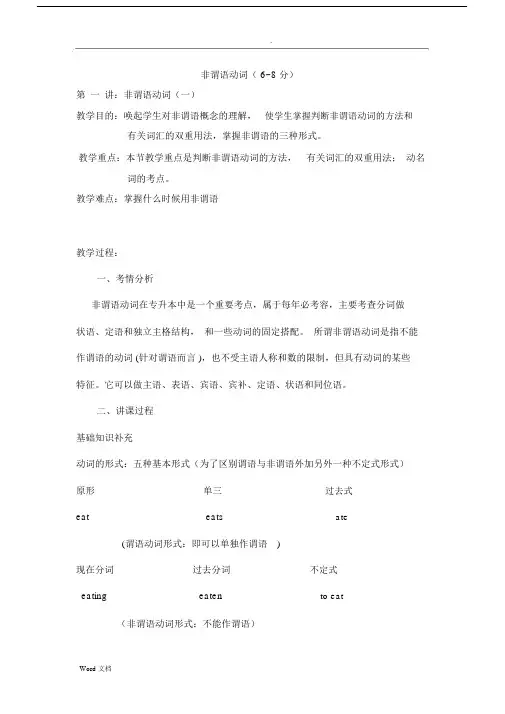
非谓语动词( 6~8 分)第一讲:非谓语动词(一)教学目的:唤起学生对非谓语概念的理解,使学生掌握判断非谓语动词的方法和有关词汇的双重用法,掌握非谓语的三种形式。
教学重点:本节教学重点是判断非谓语动词的方法,有关词汇的双重用法;动名词的考点。
教学难点:掌握什么时候用非谓语教学过程:一、考情分析非谓语动词在专升本中是一个重要考点,属于每年必考容,主要考查分词做状语、定语和独立主格结构,和一些动词的固定搭配。
所谓非谓语动词是指不能作谓语的动词 (针对谓语而言 ),也不受主语人称和数的限制,但具有动词的某些特征。
它可以做主语、表语、宾语、宾补、定语、状语和同位语。
二、讲课过程基础知识补充动词的形式:五种基本形式(为了区别谓语与非谓语外加另外一种不定式形式)原形单三过去式eat eats ate(谓语动词形式:即可以单独作谓语)现在分词过去分词不定式eating eaten to eat(非谓语动词形式:不能作谓语)He eats an orange.( 主 +谓 + 宾)I eat an orange.( 主+ 谓+ 宾)I ate an orange.( 主+ 谓+ 宾)I am eating an orange.( 主 + 谓+ 宾)He has eaten an orange.( 主 + 谓+ 宾)An orange was eaten by him.( 主+ 谓+ 宾 )I am to eat an orange.( 主+ 谓 + 宾)含义:不能做谓语的动词1、什么时候用非谓语?一句话,有谓语,多动作,无连词Seen from the top of the mountain, our school looks so beautiful.2、形式:动名词(构成:动词原形+ing )分词(现在分词、过去分词)现在分词构成:动词原形+ing过去分词构成:动词原形+ed 或 done ;动词不定式基本形式:“to+ 动词原形”,有时可省去 to非谓语动词的形式如下 :一般式完成时进行时不定式主动to do to have done to be doing.被动to be done to have doneIng 形式主动doing having done被动being done havingbeendone过去分词被动完成done非谓语动词的否定形式:not + 不定式, not +动名词,not +分词非谓语动词的语法功能一、动名词主语: Reading is my hobby.宾语: I enjoy reading.表语: My hobby is reading.定语: He is in the reading room.二、现在分词表语: The book is interesting.定语: It's an interesting book.状语: He sat there, reading a newspaper.宾补: I saw him standing there.三、过去分词表语: They were excited at the news.定语: There are a few minutes left.状语: Seen from the hill, our school looks beautiful.宾补: I saw him beaten by Tom.四、不定式主语: To catch the train is impossible.宾语: They need to look at a map.表语: My work is to clean the classroom.定语: I have lots of work to do.状语: I am sorry to trouble you.宾补: He told me to close the door.考点动名词考点一:动名词作宾语的动词1.admit doing sth.承认做某事2.advise/suggest doing sth.建议做某事3.allow/permit doing sth.允许做某事4.appreciate doing sth.感激做某事5.avoid doing sth.避免做某事6.consider doing sth.考虑做某事7.delay/put off doing sth.推迟做某事8.deny doing sth.否认做某事9.like(enjoy)/dislike doing sth. 喜欢 / 不喜欢做某事10.escape doing sth. 逃脱做某事11.fancy doing sth.喜欢做某事12.finish doing sth.完成做某事13.forbid /prohibit doing sth.禁止做某事14.forgive doing sth.原谅做某事15.give up doing sth.放弃做某事16.imagine doing sth.想象做某事17.keep doing sth.保持做某事18.mention doing sth.提及做某事19.mind doing sth.介意做某事20.miss doing sth. 错过做某事21.practice doing sth.练习做某事22.prevent doing sth.阻止做某事23.report doing sth.报告做某事24.risk doing sth. 冒险做某事25.stop doing sth.停止做某事词组: devote to,get down to,be accustomed to confess to have trouble/difficulty (in)doing sth.例题: He enjoys ___ pop music while I prefer classical music.A. listen toB. to listenC. listeningD. listening to补充知识:及物动词:后面必须跟宾语的动词,像buy,reach,give 等。
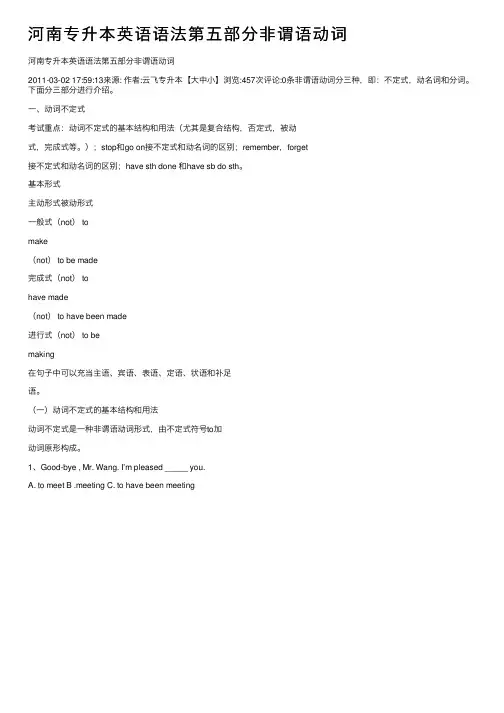
河南专升本英语语法第五部分⾮谓语动词河南专升本英语语法第五部分⾮谓语动词2011-03-02 17:59:13来源: 作者:云飞专升本【⼤中⼩】浏览:457次评论:0条⾮谓语动词分三种,即:不定式,动名词和分词。
下⾯分三部分进⾏介绍。
⼀、动词不定式考试重点:动词不定式的基本结构和⽤法(尤其是复合结构,否定式,被动式,完成式等。
);stop和go on接不定式和动名词的区别;remember,forget接不定式和动名词的区别;have sth done 和have sb do sth。
基本形式主动形式被动形式⼀般式(not) tomake(not) to be made完成式(not) tohave made(not) to have been made进⾏式(not) to bemaking在句⼦中可以充当主语、宾语、表语、定语、状语和补⾜语。
(⼀)动词不定式的基本结构和⽤法动词不定式是⼀种⾮谓语动词形式,由不定式符号to加动词原形构成。
1、Good-bye , Mr. Wang. I’m pleased _____ you.A. to meet B .meeting C. to have been meeting在句⼦中可以充当主语、表语、宾语和定语。
⼀、动名词的基本⽤法:1、We shall appreciate _____ from you soon.A. being heardB. hearingC. to hearD. having been heard(答案:B。
appreciate后接动名词做宾语。
)2、John suggested _____ anything about it until they found out more facts.A. not to sayB. saying notC. to say notD. not saying (答案:D。
suggest后接动名词做宾语,否定式要在动名词前加“not”)⼆、动名词的完成时:表⽰的动作在谓语所表⽰的动作之前发⽣时,⽤动名词的完成时。


专升本英语语法十五要点在专升本的英语学习中,语法是重要的一环。
掌握好语法,能够帮助我们更准确地理解和表达英语,从而在考试中取得好成绩。
下面就为大家详细介绍专升本英语语法的十五个要点。
一、动词时态动词时态是英语语法中的基础,也是考试中的重点。
常见的时态包括一般现在时、一般过去时、一般将来时、现在进行时、过去进行时、现在完成时、过去完成时、将来完成时等。
一般现在时表示经常发生的动作或存在的状态,如“I go to school every day”(我每天上学。
);一般过去时则用于过去发生的动作或存在的状态,“I went to the park yesterday”(我昨天去了公园。
)现在进行时表示正在进行的动作,“He is reading a book now”(他现在正在读书。
);过去进行时强调过去某个时刻正在进行的动作,“I was watching TV at 8 o'clock last night”(昨晚八点我正在看电视。
)现在完成时表示过去发生的动作对现在产生的影响或结果,“I have finished my home work”(我已经完成了作业。
);过去完成时则是过去的过去,“He had left before I arrived”(在我到达之前他已经离开了。
)二、被动语态被动语态在英语中使用广泛,其基本构成是“be +过去分词”。
例如,“The book is written by him”(这本书是他写的。
)需要注意的是,不同时态的被动语态形式有所不同,要牢记各种时态下被动语态的构成。
三、非谓语动词非谓语动词包括动词不定式、动名词和分词(现在分词和过去分词)。
动词不定式常用来表示目的、将来等,“I want to go shopping”(我想去购物。
)动名词具有名词的性质,“Swimming is my favorite sport”(游泳是我最喜欢的运动。
)现在分词表示主动和进行,过去分词表示被动和完成。
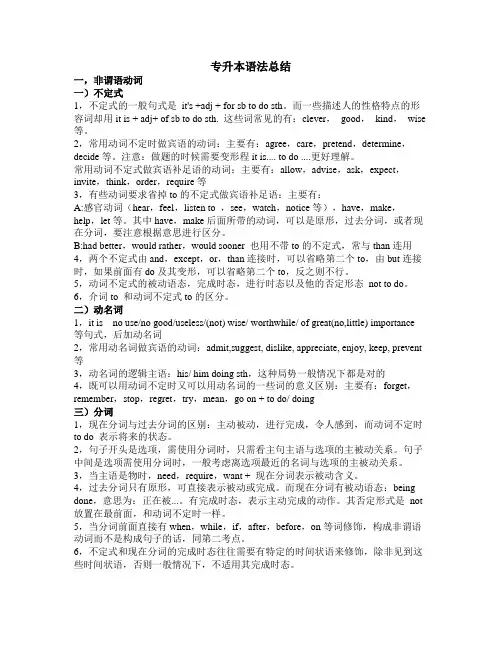
专升本语法总结一,非谓语动词一)不定式1,不定式的一般句式是it's +adj + for sb to do sth。
而一些描述人的性格特点的形容词却用it is + adj+ of sb to do sth. 这些词常见的有:clever,good,kind,wise 等。
2,常用动词不定时做宾语的动词:主要有:agree,care,pretend,determine,decide等。
注意:做题的时候需要变形程it is.... to do ....更好理解。
常用动词不定式做宾语补足语的动词:主要有:allow,advise,ask,expect,invite,think,order,require等3,有些动词要求省掉to的不定式做宾语补足语:主要有:A:感官动词(hear,feel,listen to ,see,watch,notice等),have,make,help,let等。
其中have,make后面所带的动词,可以是原形,过去分词,或者现在分词,要注意根据意思进行区分。
B:had better,would rather,would sooner 也用不带to的不定式,常与than连用4,两个不定式由and,except,or,than连接时,可以省略第二个to,由but连接时,如果前面有do及其变形,可以省略第二个to,反之则不行。
5,动词不定式的被动语态,完成时态,进行时态以及他的否定形态not to do。
6,介词to 和动词不定式to的区分。
二)动名词1,it is no use/no good/useless/(not) wise/ worthwhile/ of great(no,little) importance 等句式,后加动名词2,常用动名词做宾语的动词:admit,suggest, dislike, appreciate, enjoy, keep, prevent 等3,动名词的逻辑主语:his/ him doing sth,这种局势一般情况下都是对的4,既可以用动词不定时又可以用动名词的一些词的意义区别:主要有:forget,remember,stop,regret,try,mean,go on + to do/ doing三)分词1,现在分词与过去分词的区别:主动被动,进行完成,令人感到,而动词不定时to do 表示将来的状态。
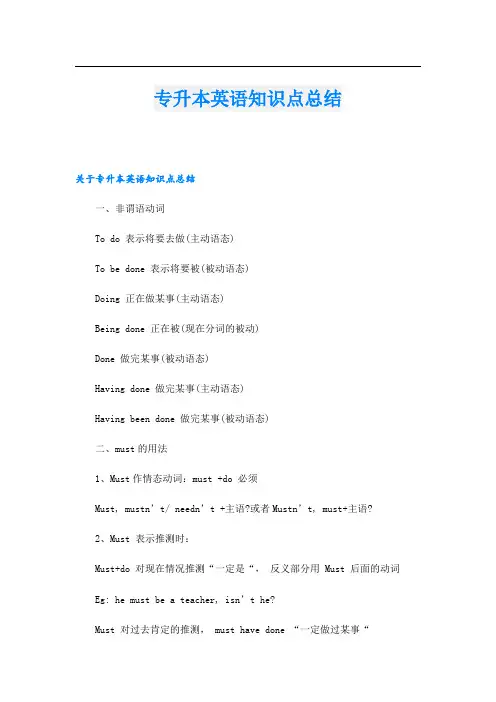
专升本英语知识点总结关于专升本英语知识点总结一、非谓语动词To do 表示将要去做(主动语态)To be done 表示将要被(被动语态)Doing 正在做某事(主动语态)Being done 正在被(现在分词的被动)Done 做完某事(被动语态)Having done 做完某事(主动语态)Having been done 做完某事(被动语态)二、must的用法1、Must作情态动词:must +do 必须Must, mustn’t/ needn’t +主语?或者Mustn’t, must+主语?2、Must 表示推测时:Must+do 对现在情况推测“一定是“,反义部分用 Must 后面的动词Eg: he must be a teacher, isn’t he?Must 对过去肯定的推测, must have done “一定做过某事“如果句中有明确的过去时间,(yesterday/last week/month/year/night), 反义部分用 didnt + 主语?Eg: it must have rained last night, didnt it?如果句中没有明确的过去时间词,反义部分用 havent /hasnt+主语?it must have rained, hasnt it?专升本英语重点知识点Part 1——英语单词"X,Y,Z"篇1.Xmas n. 圣诞节2.xylitol n. 木糖醇3.X-RAY n.X射线4.xenidium n.胶合板5.xerocopy n. 复印件6.xerodermia n. 皮肤干燥症,干皮病7.xerography n. 静电复印术8.xeroma n. 干性眼炎,干眼病9.xenogeneic adj. 异种的,异基因的10.xenogenetic adj. 自然发生的11.xenon n. 氙(惰性气体,元素符号Xe)12.xenophobia n. 仇外,惧外者13.xeranthemum n.干鲜花卉14.yield vi.屈服15.yet adv.尚,还,仍然,已经16.young adj.年轻的,年幼的17.youngster n. 青春,年轻人18.yawn v. 打呵欠,张开, 裂开;n. 呵欠19.zone n.地区,区域20.zoo n.动物园Part 2——单项选择题名词及所有格:1. ________ mothers couldnt go to the meeting, because they have gone to Shanghai .A. Mary and PetersB. Mary and PeterC. Marys and PeterD. Marys and Peters2. Li Lei has been to __________ many times this month.A. her uncleB. her unclesC. her unclesD. aunts3. He is a success as a leader but he hasnt ________ in teaching.A. many experiencesB. much experienceC. an experienceD. a lot experience4. A classmate of _________ was here ten minutes ago.A. youB. yourC. your sisterD. your sisters5. A group of _________ are talking with two ___________.A. Frenchmen, GermansB. Germans ,FrenchmansC. Frenchmans , GermenD. Germen , Frenchmen答案 1-5 D B B D A学好英语最有效4个方法1、单词是基础记单词需要灵活,别死记,并且要多看它,把书上的单词归纳到自己的笔记本上,并附上词组,一举两得。
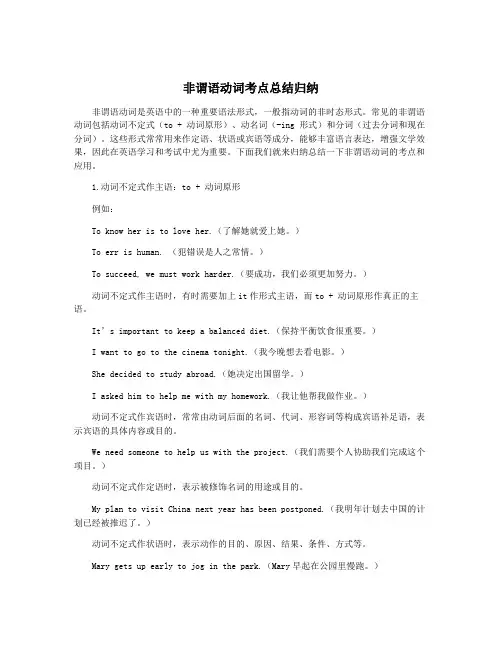
非谓语动词考点总结归纳非谓语动词是英语中的一种重要语法形式,一般指动词的非时态形式。
常见的非谓语动词包括动词不定式(to + 动词原形)、动名词(-ing 形式)和分词(过去分词和现在分词)。
这些形式常常用来作定语、状语或宾语等成分,能够丰富语言表达,增强文学效果,因此在英语学习和考试中尤为重要。
下面我们就来归纳总结一下非谓语动词的考点和应用。
1.动词不定式作主语:to + 动词原形例如:To know her is to love her.(了解她就爱上她。
)To err is human. (犯错误是人之常情。
)To succeed, we must work harder.(要成功,我们必须更加努力。
)动词不定式作主语时,有时需要加上it作形式主语,而to + 动词原形作真正的主语。
It’s important to keep a balanced diet.(保持平衡饮食很重要。
)I want to go to the cinema tonight.(我今晚想去看电影。
)She decided to study abroad.(她决定出国留学。
)I asked him to help me with my homework.(我让他帮我做作业。
)动词不定式作宾语时,常常由动词后面的名词、代词、形容词等构成宾语补足语,表示宾语的具体内容或目的。
We need someone to help us with the project.(我们需要个人协助我们完成这个项目。
)动词不定式作定语时,表示被修饰名词的用途或目的。
My plan to visit China next year has been postponed.(我明年计划去中国的计划已经被推迟了。
)动词不定式作状语时,表示动作的目的、原因、结果、条件、方式等。
Mary gets up early to jog in the park.(Mary早起在公园里慢跑。
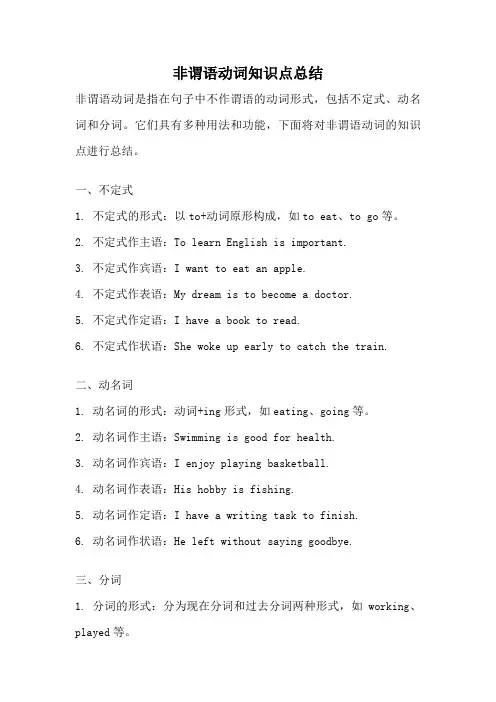
非谓语动词知识点总结非谓语动词是指在句子中不作谓语的动词形式,包括不定式、动名词和分词。
它们具有多种用法和功能,下面将对非谓语动词的知识点进行总结。
一、不定式1. 不定式的形式:以to+动词原形构成,如to eat、to go等。
2. 不定式作主语:To learn English is important.3. 不定式作宾语:I want to eat an apple.4. 不定式作表语:My dream is to become a doctor.5. 不定式作定语:I have a book to read.6. 不定式作状语:She woke up early to catch the train.二、动名词1. 动名词的形式:动词+ing形式,如eating、going等。
2. 动名词作主语:Swimming is good for health.3. 动名词作宾语:I enjoy playing basketball.4. 动名词作表语:His hobby is fishing.5. 动名词作定语:I have a writing task to finish.6. 动名词作状语:He left without saying goodbye.三、分词1. 分词的形式:分为现在分词和过去分词两种形式,如working、played等。
2. 现在分词作主语:Reading helps improve vocabulary.3. 现在分词作宾语:She heard someone calling her name.4. 现在分词作表语:He is a hardworking student.5. 现在分词作定语:I saw a running dog in the park.6. 现在分词作状语:He left the room, closing the door behind him.7. 过去分词作宾语补足语:I found the door closed.四、非谓语动词的逻辑主语1. 不定式的逻辑主语:It is important to learn English.2. 动名词的逻辑主语:Swimming helps improve health.3. 分词的逻辑主语:Reading books is beneficial for children.五、非谓语动词的否定形式1. 不定式的否定形式:not+不定式,如not to go、not to eat等。
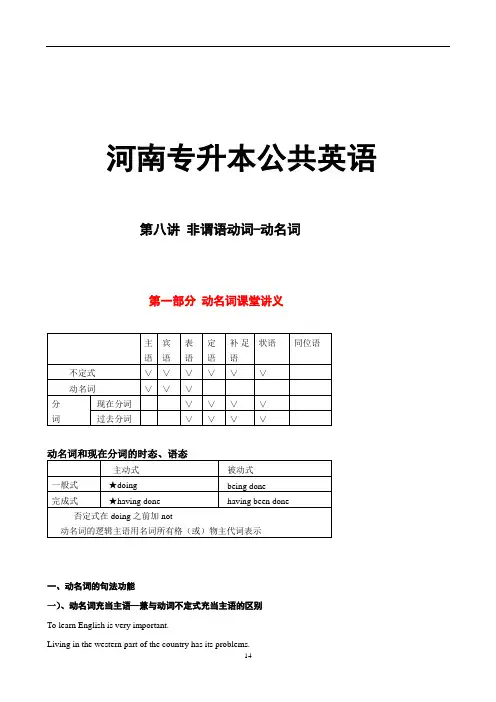
河南专升本公共英语第八讲非谓语动词-动名词第一部分动名词课堂讲义一、动名词的句法功能一)、动名词充当主语—兼与动词不定式充当主语的区别To learn English is very important.Living in the western part of the country has its problems.动词不定式和动名词充当主语的区别a.不定式表一次性的动作,动名词表反复性、经常性的动作b.不定式表结果,动名词表过程【单选模拟试题】1. ________in the matriculation for high school graduates in a short time is really a hard nut.A. To make high scoresB. Making high scoresC. To make low goalD. Making low goal2. It’s necessary to be pr epared for a job interview. _______ the answer ready will be of great help.A. To have hadB. Having hadC. Have hadD. Having【注】:动名词充当主语通常出现在以下结构中:Crying over spilt milk is no use.It is no use crying over spilt milk.no useIt is no good +doingno senseno pointworthIt is worth reading.being readno usethere is no good +doingno senseno pointIt is a waste of time arguing about it.【单选历年考试真题】[11---35]. raw materials into useful products is called manufacturing.A. TransformB. TransformingC. Being transformedD. When transforming[13--40].______to sunlight for t oo much time will do harm to one’s skin.A. ExposedB. Having exposedC. Being exposedD. After being attention [01—18] It’s no use _____about the bad service in this hotel.A. complainingB. complainC. to complainD. to be complained[09—17].It is no use me not to worry about his injury.A. for you to tellB. your tellingC. you tellD. having told[05—30]There is no ____ arguing about it, just do as you are told.A. reasonB. wayC. pointD. meaning [10—31]. It’s no use _______ with him since he has made up his mind.A. to argueB. arguingC. to be arguedD. argued 【单选模拟试题】1. ---What do you think of the book?---Oh, excellent. It’s worth _________ a second time.A. to readB. to be readC. readingD. being read 【翻译历年考试真题】[14—87]. It’s no good learning English without practice.译文:________________________________________________________ 。
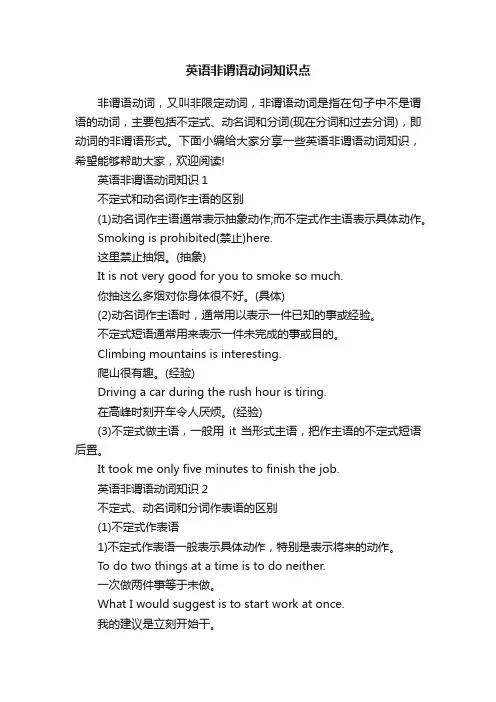
英语非谓语动词知识点非谓语动词,又叫非限定动词,非谓语动词是指在句子中不是谓语的动词,主要包括不定式、动名词和分词(现在分词和过去分词),即动词的非谓语形式。
下面小编给大家分享一些英语非谓语动词知识,希望能够帮助大家,欢迎阅读!英语非谓语动词知识1不定式和动名词作主语的区别(1)动名词作主语通常表示抽象动作;而不定式作主语表示具体动作。
Smoking is prohibited(禁止)here.这里禁止抽烟。
(抽象)It is not very good for you to smoke so much.你抽这么多烟对你身体很不好。
(具体)(2)动名词作主语时,通常用以表示一件已知的事或经验。
不定式短语通常用来表示一件未完成的事或目的。
Climbing mountains is interesting.爬山很有趣。
(经验)Driving a car during the rush hour is tiring.在高峰时刻开车令人厌烦。
(经验)(3)不定式做主语,一般用it当形式主语,把作主语的不定式短语后置。
It took me only five minutes to finish the job.英语非谓语动词知识2不定式、动名词和分词作表语的区别(1)不定式作表语1)不定式作表语一般表示具体动作,特别是表示将来的动作。
To do two things at a time is to do neither.一次做两件事等于未做。
What I would suggest is to start work at once.我的建议是立刻开始干。
2)如果主语是不定式(表示条件),表语也是不定式(表示结果)。
To see is to believe.百闻不如一见。
To work means to earn a living.工作就是为了生活。
3)如果主语是以aim, duty, hope, idea, happiness, job,plan,problem,purpose,thing,wish等为中心的名词,或以what引导的名词性从句,不定式作表语是对主语起补充说明作用。
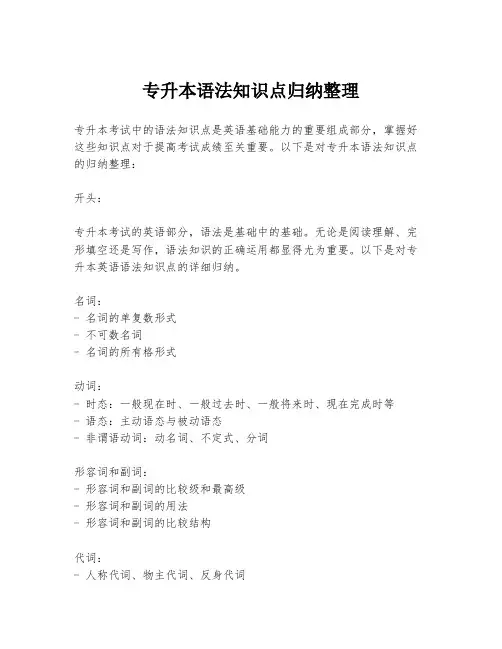
专升本语法知识点归纳整理专升本考试中的语法知识点是英语基础能力的重要组成部分,掌握好这些知识点对于提高考试成绩至关重要。
以下是对专升本语法知识点的归纳整理:开头:专升本考试的英语部分,语法是基础中的基础。
无论是阅读理解、完形填空还是写作,语法知识的正确运用都显得尤为重要。
以下是对专升本英语语法知识点的详细归纳。
名词:- 名词的单复数形式- 不可数名词- 名词的所有格形式动词:- 时态:一般现在时、一般过去时、一般将来时、现在完成时等- 语态:主动语态与被动语态- 非谓语动词:动名词、不定式、分词形容词和副词:- 形容词和副词的比较级和最高级- 形容词和副词的用法- 形容词和副词的比较结构代词:- 人称代词、物主代词、反身代词- 指示代词、疑问代词、不定代词冠词:- 不定冠词和定冠词的使用- 冠词的省略介词:- 介词的用法- 介词短语的构成连词:- 并列连词和从属连词- 连词在句子中的作用数词:- 基数词和序数词- 数词在句子中的使用句子结构:- 简单句、并列句、复合句- 主语、谓语、宾语、定语、状语、补语非谓语动词的用法:- 动名词作主语、宾语等- 不定式作目的状语、结果状语等- 分词作定语、状语等时态的一致性:- 时态的一致性原则- 不同时态的转换被动语态的构成:- 被动语态的构成方法- 被动语态的使用场合倒装句和强调句:- 倒装句的构成和用法- 强调句的构成和用法结尾:通过上述对专升本英语语法知识点的归纳整理,考生们可以更有针对性地复习和准备考试。
语法是英语学习的基石,只有扎实掌握语法知识,才能在专升本考试中取得优异的成绩。
希望每位考生都能够通过努力,实现自己的学业目标。
结束语:最后,祝愿所有考生在专升本考试中取得理想的成绩,为自己的未来铺设坚实的基础。
非谓语动词知识点总结导图非谓语动词是动词的一种形式,它有三种形式,分别是不定式、动名词和分词。
非谓语动词在句子中不充当谓语,而是充当其他成分。
非谓语动词有自己的语法特点和用法,掌握非谓语动词的知识对于英语学习者来说非常重要。
一、不定式1. 不定式的形式不定式是动词的一种形式,由“to + 动词原形”构成。
例如:to go, to eat, to study等。
2. 不定式的用法(1)作主语To study English every day is important.每天学习英语很重要。
(2)作宾语I want to go to the library.我想去图书馆。
(3)作定语I have some books to read.我有一些书要读。
(4)作状语She gets up early to catch the early bus.她早起是为了赶早班车。
3. 不定式的否定形式不定式的否定形式是“not to + 动词原形”。
例如:not to go, not to eat, not to study等。
4. 不定式的完成形式不定式的完成形式是“to have + 过去分词”。
例如:to have seen, to have done等。
5. 不定式的时态不定式没有时态的变化,它不受主语的人称和数的变化而变化。
例如:I like to read books.我喜欢读书。
She likes to read books.她喜欢读书。
二、动名词1. 动名词的形式动名词是动词的一种变化形式,它的形式是动词原形加上-ing。
例如:reading, writing, swimming等。
2. 动名词的用法(1)作主语Reading novels is interesting.读小说很有趣。
(2)作宾语I enjoy swimming.我喜欢游泳。
(3)作定语The singing bird is beautiful.唱歌的鸟很美。
非谓语动词知识点总结非谓语动词是英语语法中重要的一部分,它包括不定式、动名词和分词。
掌握非谓语动词的用法和特点对于学习英语语法和提高语言表达能力非常重要。
本文将对非谓语动词的知识点进行总结和归纳。
一、不定式1. 不定式的基本形式:不定式是动词的一种形式,一般由“to + 动词原形”构成,例如:to go, to eat, to play等。
不定式可以作为动词、名词或形容词的宾语、表语、定语等。
2. 不定式的用法:a. 作为动词的宾语:He wants to go home. (他想回家。
)b. 作为名词的宾语:I like to swim. (我喜欢游泳。
)c. 作为形容词的宾语补足语:It is difficult to learn a new language. (学一门新语言很困难。
)3. 不定式的否定形式:不定式的否定形式通常是在“to”之前加上“not”,构成“not to + 动词原形”,例如:not to go, not to eat等。
4. 不定式的完成形式:不定式的完成形式由“to have + 动词过去分词”构成,例如:to have gone, to have eaten等。
5. 不定式的被动形式:不定式的被动形式由“to be + 动词过去分词”构成,例如:to be done, to be eaten等。
6. 不定式的完成被动形式:不定式的完成被动形式由“to have been + 动词过去分词”构成,例如:to have been done, to have been eaten等。
二、动名词1. 动名词的基本形式:动名词是动词的一种形式,一般以动词原形加上-ing构成,例如:going, eating, playing等。
动名词可以作为名词的主语、宾语、表语等。
2. 动名词的用法:a. 作为名词的主语:Swimming is good exercise. (游泳是一项好的锻炼。
非谓语动词的用法一、知识点回顾非谓语动词包括不定式、分词(现在分词和过去分词)和动名词。
在句子中可担任除谓语外所有其他成分。
(一)动词不定式动词不定式的用法:1.作主语。
不定式作主语时常用it作形式主语,而把真正的主语放在后面。
To help others is my duty.→It is my duty to help others.帮助别人是我的职责。
2.作表语。
Her job at that time was to look after the sick boy.她当时的任务就是看护这个生病的男孩。
3.作宾语。
常用在下列动词后面:want, need, hope, wish, expect, intend, plan, mean, prefer, hate, like, try, manage, remember, forget, begin, start, agree, refuse, learn。
在teach, know,show等词后则多接疑问词加不定式。
He has agreed to help me with my English.他答应帮我学习英语。
4.作宾语补足语或主语补足语。
常接不定式作宾语补足语或主语补足语的动词有ask, advise, allow, beg, cause, force, get, help, permit, order, want, wish, tell等,但hope, suggest,agree和demand不接不定式作宾语补足语。
5.作定语。
I had no chance to go to school at that time.我当时没有机会上学。
6.作状语。
(1)作目的状语:to do, in order to do, so as to do(不能用于句首)。
They all rushed out to have a look at the film star.他们都跑出去看电影明星。
ENGLISH ON CAMPUS2022年28期总第624期专升本英语考试中非谓语动词题的解题技巧及备考策略摘 要:非谓语动词是专升本英语考试中令考生觉得茫然不解的高频考点。
本文通过对非谓语动词进行归类、整理分析,总结出相应的解题技巧及其备考策略,帮助学生理清头绪,更加清楚地理解非谓语动词,以便高效、正确地做题。
关键词:非谓语动词;专升本;解题技巧;备考策略作者简介:谢美丽(1992-),女,河南开封人,湖州师范学院教师教育学院,在校研究生,专升本英语讲师,研究方向:专升本英语教学、校园安全管理。
对于即将参与专升本考试的学生来讲,非谓语动词是他们学习英语语法过程中最为头疼的事情,学生如果能够掌握一定的解题技巧和备考策略,那么理解和学习起来就会容易很多,做题也会事半功倍。
一、动词的分类英语的动词可分为两种,分别是谓语动词和非谓语动词。
“谓语动词”又简称“谓语”,它表示主语的动作或状态,因此常由动词充当,且常位于主语的后面。
而非谓语动词是在谓语动词前加了一个“不”字,“不”就是“不能”的意思,所以非谓语动词指不能单独作谓语的动词形式(主语的人称和数没有限制),虽然不能单独做谓语,但可以做其他成分(主语、宾语、表语、定语、状语、补语)。
例如,在“He came in.”中,He是主语,came in为谓语动词;在“He came in and he smiled at me.”中,He 是主语,came in充当谓语动词,在“He came in,smiling at me.”这个例句当中,与之前两个例句相比,少了一个连词,所以非谓语动词的使用条件为:在没有连词的情况下,在英语简单句中有且只有一个谓语动词,如果出现其他动词,那么就用非谓语形式。
非谓语动词的基本形式有 doing、done和to do。
二、非谓语动词的句法功能(一)非谓语动词作主语(无done形式)to do 表示具体或一次性的动作,doing一般表示经常的动作。
专升本英语非谓语动词的重点:
1,consider it +adj + to do 考虑做。
如何
2,find it +adj +to do 发现做。
如何
3,make it +adj +to do 使得做。
如何
4,regard it +adj +to do 对待。
如何
5,think it +adj +to do 认为做。
如何
6,feel it +adj +to do 感觉做。
如何
7,I buy some books to read during my spare time 我买了一些书去读在我的空闲时间。
(to do ,将来)
8,Have sb do 让某人做
9,Make sb do 是某人做
10,Hear sb do 听见某人做
11,Listen to sb do sth 听某人做某事
12,Look at sb do sth 看着某人做某事
13,Notice sb do sth 注意某人做某事
14,Observe sb do 观察某人做某事
15,See sb do sth 看见某人做某事
16,Watch sb do sth 观看某人做某事
17,The car to be fixed is my friend’s 这个将要被修理的车是我的朋友的(to be done ,将来)
18,It is no use/good, fun, a waste of time ,a good pleasure, help, useless)+doing 做。
是没有。
19,Forget to do 忘记去做,forget doing 忘记做过
20,Mean to do 打算去做,mean doing 意味着做某事
21,Remember to do 记得去做,remember doing 记得做过
22,Try to do 努力去做,try doing 尝试做某事
23,Go on to do 继续去做另一件事,go on doing 继续去做同一件事
24,Regret to do 后悔去做,regret doing 后悔做过
25,Stop to do 停下来去做,stop doing 停止做。
26,Can’t help doing 情不自禁做,can’t help to do 不能帮助去做。
27,I enjoy being invited (我享受被邀请,enjoy doing ,又要被动,)
28,Hearing the news ,we are so happy 听见这个消息,我们很开心
29,I found some students singing in the classroom 我发现一些学生在教室里唱歌
30,Having done my work ,I started to answer your questions 完成了我的工作之后,我开始回答你的问题
31,Having been stuck in the mud ,it was pulled out by many kind hearted men 这个车被堵在泥土里以后,被很多的好心人移出来了。
32,Moved by what he had seen in the poor area,he went there many times 由于被他在贫困地区看到的一切所感动,它去了那里许多次。
33,If the weather permits=weather permitting,I will go swimming 如果天气允许,我就要去游泳。
34,。